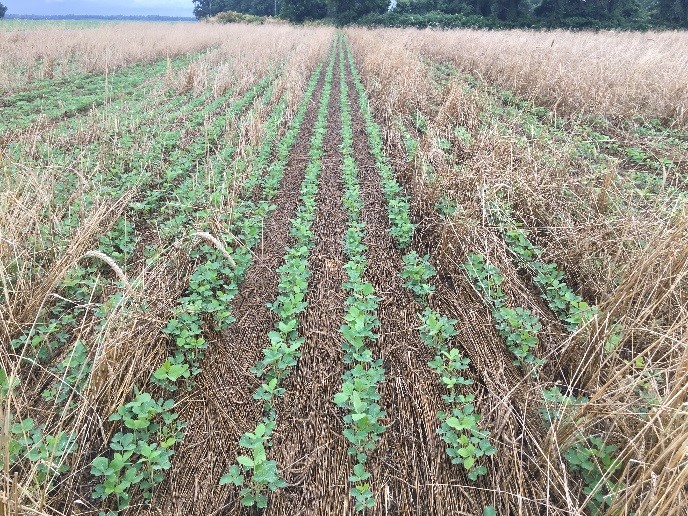 Heat unit accumulation has been the big question over the past week. Mild temperatures settled over Tennessee during early August and there is some concern that the crop may not be maturing as quickly as noted in years past. While I agree the weather has been quite comfortable, we are currently very close to the 30 year average heat unit accumulation trend noted from 1980-2010.
Heat unit accumulation has been the big question over the past week. Mild temperatures settled over Tennessee during early August and there is some concern that the crop may not be maturing as quickly as noted in years past. While I agree the weather has been quite comfortable, we are currently very close to the 30 year average heat unit accumulation trend noted from 1980-2010.
Recent Updates
Consider Establishing a Cover Crop this Fall

PPO-resistant Palmer amaranth has required growers to adapt to an integrated weed control approach with the assistance of the new technologies available. The adoption of cover crops in the state has shown to be a major tool for successfully controlling Palmer amaranth. Furthermore, Palmer amaranth infested fields in Tennessee are cleaner this year compared to the last decade. Continue reading
Crop Progress – Tennessee and U.S.
PRODUCERS READYING FOR CORN HARVEST
Corn producers are checking equipment in anticipation of the start of harvest. The crop looks promising and good yields are expected. Additionally, last week’s soaking rains improved crop conditions, particularly late planted corn and soybeans. Pasture conditions also showed improvement. There were 4.4 days suitable for field work. Topsoil moisture was 5 percent very short, 9 percent short, 79 percent adequate and 7 percent surplus.
Subsoil moisture was 5 percent very short, 13 percent short, 77 percent adequate and 5 percent surplus. Continue reading at TN_08_21_17. The U.S. Crop Progress report can be read at CropProg-08-21-2017.
Tennessee Market Highlights
Corn, cotton, soybeans, and wheat were down for the week.
Cash corn prices moved lower this week. In Tennessee, cash corn prices typically
achieve the marketing year low in August or September. In eight of the last
eleven years, the lowest monthly average price occurred in August or September
(four times each). From 2006 to 2016, monthly average corn prices were 48 cents lower than the marketing year average (the corn marketing year is Sept 1 to Aug 31). In Tennessee, the monthly average high typically occurs in July – on average 58 cents per bushel more than the final marketing year average price. From September to January, average monthly prices typically strengthen, relative to the marketing year average (Sept -$0.48, Oct -$0.44, Nov -$0.24, Dec -$0.18, & Jan -$0.13). On farm or commercial storage allows producers to take advantage of “typical” price improvements. Continue reading at Tennessee Market Highlights.
UT Extension Commodity Update
Corn: September corn futures have traded $0.08 lower so far this week. The decline in corn futures can be attributed to a lack of a weather scare for the Midwest. Key growing states like Iowa and Illinois continue to receive extended weather forecasts with normal temperatures and normal precipitation. The USDA released the latest crop progress report on Monday. This report indicated that 97% of the corn crop is silking while 61% of the crop has reached the dough stage. The USDA rated 62% of the corn crop as being good-to-excellent, which is a 2% increase from last week’s report. Continue reading
Guidance to Handling Dicamba Damage Claims
Guidance to Handling Dicamba Damage Claims
If you have been to any agricultural field day, then you have heard mention of dicamba drift. Whether you are a producer or an agribusiness professional, dicamba is on the forefront of everyone’s’ mind. Some states have outright banned the chemical’s use while others have provided extra guidance on how to apply the herbicide. Whether you farm in the Midwest or the Mid-south, dicamba is an issue that must be addressed. The yield loss from dicamba drift is not yet known and will be unique for each drift occurrence. Continue reading

Fighting Bollworms in Late Cotton or Soybean
Although many of our early maturing fields are out of the woods, I continue to get calls about bollworms (corn earworm) in later maturing cotton and soybean. As a reminder, there are a couple of factors in play that need to be considered. Continue reading
Crop Progress – Tennessee and U.S.
THUNDERSHOWERS SLOW FIELD WORK
Spotty thundershowers, some heavy, returned to the state last week, slowing field work but bringing welcome moisture. Corn producers were getting ready for harvest, while other row crop producers were busy with weed control. Hay producers were working on their second or third cuttings. Some Bermuda grass pastures were showing signs of stem maggot infestation. There were 5.0 days suitable for field work. Topsoil moisture was 9 percent very short, 12 percent short, 70 percent adequate and 9 percent surplus. Subsoil moisture was 7 percent very short, 13 percent short, 72 percent adequate and 8 percent surplus. Continue reading at TN_08_14_17. The U.S. Crop Progress report can be read at CropProg-08-14-2017.

